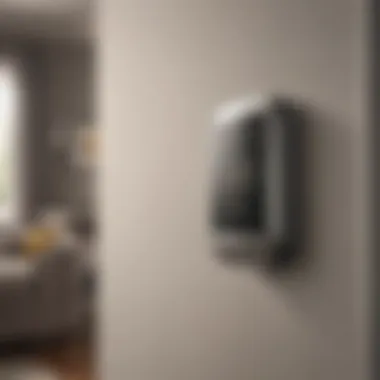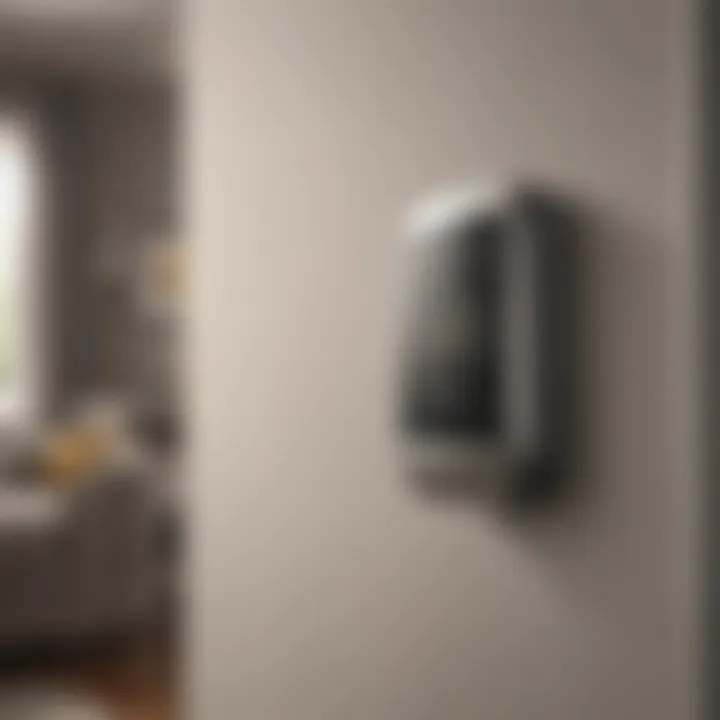Smart Ways to Slash Your Electric Bill


Intro
Electric bills can be a significant strain on household budgets. With rising energy costs, understanding how to effectively manage this expense becomes crucial. This article aims to provide practical strategies to lower your electric bill. It is designed for those who want to make informed decisions about their energy consumption. Together, we will explore various methods that include behavioral changes, energy-efficient practices, and the use of technology.
Overview of Energy-Efficient Practices
Definition
Energy-efficient practices refer to methods and behaviors that use less energy while still providing the same service. They encompass a range of actions, from simple changes in daily habits to larger investments in technology.
Key Features
- Smart Thermostats: These devices learn your schedule and adjust temperatures for optimal efficiency.
- Energy-Efficient Appliances: Appliances like washing machines and refrigerators that consume less power.
- LED Lighting: Replacing incandescent bulbs with LED lights reduces energy use significantly.
Purpose and Benefits
The main goal of implementing these practices is to lower energy consumption and promote sustainability. Reducing energy use not only saves money but also benefits the environment. Individuals and families can reduce their carbon footprint while enjoying lower bills.
"Reducing energy consumption not only eases financial pressure but also plays a crucial role in environmental sustainability."
Behavioral Changes to Reduce Consumption
Simple Adjustments
- Unplug Devices: Electronics consume energy even when off. Unplugging them can lead to savings.
- Mindful Use of Heating and Cooling: Adjusting thermostats by just a few degrees can significantly impact your bill.
- Limit Use of Non-Essential Lighting: Turning off lights in unoccupied rooms is an effortless way to save energy.
Creating a Consumption Schedule
Developing a routine can help identify peak usage times. Create a plan for when to run heavy appliances, like dishwashers or washing machines, during off-peak hours.
Technology and Smart Devices
Smart Home Technology
Investing in smart home devices can yield significant savings. Smart plugs and energy monitors allow you to track your energy usage in real time. Being aware of consumption patterns can lead to more careful use.
Solar Panels
For long-term savings, solar panels present a viable option. The initial investment can be high, but the reduction in traditional energy costs can be substantial over time. Plus, many regions offer incentives for solar energy use, which further enhances the financial aspect.
End
Understanding and implementing effective strategies to reduce electric bills is essential for financial health. From energy-efficient practices to thoughtful behavioral changes and smart technologies, there are numerous ways to achieve lower utility costs. Each small adjustment contributes to significant savings over time. By adopting these strategies, individuals and families can not only improve their financial standing but also contribute positively to the environment.
Understanding Your Electric Bill
Understanding your electric bill is essential for anyone looking to reduce their energy expenses. It serves as a window into your home’s energy consumption and can reveal areas where savings are possible. Not only does it help to identify what you are paying for, but it also informs the strategies and actions that can lead to lower bills. By dissecting the bill, homeowners gain insights into their usage patterns and costs, which can lead to more informed decisions regarding energy habits and choices.
Components of Your Bill
An electric bill typically consists of several components that determine your total charges. Here are the key elements:
- Energy Charges: This is the most significant part, based on how much electricity you consume, measured in kilowatt-hours (kWh).
- Demand Charges: This may apply for larger households or businesses and refers to the maximum amount of electricity used at once.
- Taxes and Fees: Local and state subsidies, along with fees associated with the delivery of power, can add to the total.
- Other Charges: Look for any programs or services offered by your utility provider, which can impact your total cost.
Mapping out these components can help you identify areas for potential savings.
Analyzing Usage Patterns
Analyzing your electricity usage patterns is critical. Start by reviewing your bill over several months to observe trends. Look for:
- Seasonal Variations: Energy costs may fluctuate with different seasons. Recognizing these patterns helps you prepare for peak usage periods.
- Daily Consumption: Identifying high-consumption days or hours can spotlight your energy habits that may need adjustments.
Tracking energy use can be easier with online tools provided by many energy companies. These platforms may feature insights and comparisons to similar households.


Identifying Peak Hours
Knowing the peak and off-peak hours can have a substantial impact on your electric bill. Most utility companies charge higher rates during peak hours. This can vary based on local regulations, so it is wise to check with your provider. By shifting energy-intensive tasks, such as washing clothes or running the dishwasher to off-peak times, you can significantly lower costs. Using timers or scheduling these activities can prove beneficial in managing usage effectively.
Energy Efficiency in Your Home
Energy efficiency in your home is a key concept in reducing electricity consumption and thus lowering electric bills. By making smart choices and adjustments, homeowners can significantly optimize their energy use. Not only does this lead to cost savings, but it also contributes to environmental sustainability. There are several elements involved in improving energy efficiency, including appliances, technology, and lighting. Each of these aspects not only impacts your wallet but also plays a role in the home's overall energy footprint.
Investing in Energy-Efficient Appliances
Investing in energy-efficient appliances is one of the most impactful steps towards reducing your electric bill. These appliances use less energy compared to their conventional counterparts, saving money in the long run. When you consider upgrading, check for the ENERGY STAR label. This certification indicates that the appliance meets strict energy efficiency guidelines set by the U.S. Environmental Protection Agency.
For instance, replacing an old refrigerator can yield significant savings. An older model may use as much as 50% more energy than a new energy-efficient refrigerator. In addition, consider how often certain appliances are used. For instance, a washing machine that optimizes water use while incorporating energy-efficient cycles can result in substantial savings over time.
Utilizing Smart Home Technology
Incorporating smart home technology is another effective strategy for enhancing energy efficiency. Devices like smart thermostats, lighting systems, and energy monitors can help optimize energy use across various household functions. A smart thermostat, for example, can adjust the temperature based on your routines and preferences, helping to reduce unnecessary heating or cooling when no one is home.
Moreover, smart plugs allow you to control when devices draw power. This is especially relevant for electronics that consume energy even when idle, such as computers and chargers. Monitoring energy consumption is simple with these tools, providing insights into which devices consume the most energy and facilitating informed decisions on usage.
LED Lighting Solutions
Switching to LED lighting solutions is a straightforward yet effective way to improve energy efficiency in your home. LED bulbs use far less energy than traditional incandescent bulbs while providing the same brightness. They also have a longer lifespan, reducing the need for frequent replacements.
To illustrate, an LED bulb uses about 75% less energy than a standard incandescent bulb. Additionally, they emit less heat, contributing to lower cooling costs during warmer months. When selecting lighting, consider the areas in your home that are used the most and replace those fixtures with LED options.
Behavioral Changes to Lower Consumption
Understanding how behavioral changes can minimize electric consumption is crucial for any household looking to decrease their bills. This section highlights practical adjustments that do not require substantial investments but can significantly affect energy usage. Small changes in daily habits can lead to noticeable savings and contribute to a more sustainable lifestyle.
Adjusting Thermostat Settings
Temperature control is a primary factor affecting energy consumption. Adjusting the thermostat settings can lead to substantial cost savings while maintaining comfort in your home. For cooling, it is suggested to set the thermostat at 78°F (around 25.5°C) when home and higher when you are away. For heating, lowering it to 68°F (about 20°C) during winter months can also provide savings. Consider using a programmable thermostat to automate these settings according to your schedule. This way, you can avoid unnecessary heating or cooling when no one is home.
Practicing Responsible Water Heating
Water heating can account for a significant portion of energy bills. Therefore, being mindful of water heating practices can effectively reduce consumption. First, consider setting your water heater to 120°F (49°C). This temperature is usually sufficient for most household tasks and can prevent scalding. Also, insulating your water heater and the first six feet of hot water pipes can minimize heat loss, resulting in energy savings. Lastly, be conscious of your hot water usage habits. Taking shorter showers and avoiding bathtub fills more frequently can lead to noticeable reductions in hot water usage, thus lowering overall energy consumption.
Unplugging Idle Electronics
Electronics and devices that remain plugged in, even when not in use, can contribute to what is known as phantom load. This term describes the energy consumed by appliances in standby mode, which can add up over time. Encourage everyone in the home to unplug devices such as chargers, coffee makers, or gaming consoles when they are not actively being used. Alternatively, using smart power strips can help manage this issue. These devices can cut off power to connected devices when they are not in use, effectively reducing the overall energy consumed significantly.
Behavioral changes do not always require large investments. Small, consistent adjustments can accumulate into significant savings.
Insulation and Home Improvements
Effective insulation and home improvements play a crucial role in reducing electric bills. Proper insulation minimizes heat transfer, leading to more stable indoor temperatures. This stability enables heating and cooling systems to work more efficiently, yielding lower energy consumption. Furthermore, home improvement projects focused on insulation add value to properties.
Investing in insulation not only decreases energy bills but also enhances comfort within living spaces. Cold drafts in winter and excessive heat in summer can lead to discomfort. By addressing these issues, homeowners can create a more pleasant environment year-round.
Improving Insulation in Your Home
Improving insulation is a multi-faceted approach. There are various areas to focus on, such as walls, attics, and basements. Each type of insulation material has distinct qualities. Fiberglass batts, spray foam, and cellulose are common options.
When upgrading insulation, consider R-value, which measures thermal resistance. Higher R-values indicate better insulation. For attics, aiming for an R-value of 30-60 is often recommended, while walls typically require an R-value of 13-23.
Here are steps for effective insulation improvement:
- Assess current insulation: Inspect areas like attics and basements for existing insulation and its condition.
- Choose the right material: Select insulation based on the specific area and desired R-value.
- Install properly: Ensure that insulation is installed without gaps or compression to maximize effectiveness.
Sealing Drafts and Gaps
Sealing drafts and gaps is another important strategy for enhancing energy efficiency. Small openings around windows, doors, and other fixtures can lead to significant energy loss. Air leaks can increase heating and cooling costs by making systems work harder.
To effectively seal drafts, consider these methods:


- Use caulk: Fill gaps around windows, doors, and siding with caulk.
- Weather stripping: Apply weather stripping around movable parts of windows and doors.
- Insulation foam: For larger gaps, spray foam can provide an effective seal.
Regular inspections will help identify new or worsening leaks, allowing for prompt repairs.
Window Treatments for Energy Saving
Window treatments can also significantly impact energy efficiency. The right type can minimize heat loss in winter and heat gain in summer.
Here are common options for window treatments that contribute to energy savings:
- Curtains or Drapes: Insulated curtains can reduce heat transfer. Open them during sunny days to warm up rooms naturally and close them at night to retain warmth.
- Shades and Blinds: Cellular shades are designed to trap air and provide extra insulation. Some blinds can reflect heat away from the house in the summer.
- Window Films: These films can block UV rays, reducing heat gain and glare. This not only improves comfort but also protects furnishings.
In essence, enhancing insulation and making strategic home improvements create a more energy-efficient environment. This brings satisfaction through lower energy costs and improved comfort in living spaces.
Alternative Energy Sources
Alternative energy sources play a crucial role in reducing electric bills. By incorporating renewable energy options like solar and wind, homeowners can significantly decrease their dependence on traditional electricity sources. This transition not only leads to lower monthly expenses but also contributes to environmental sustainability. Understanding how to effectively explore and implement these energy sources is highly important.
Exploring Solar Energy Options
Solar energy offers a viable solution for reducing electric bills. This energy is abundant and renewable, harnessed through photovoltaic cells that convert sunlight into electricity. One of the main advantages of solar energy is that it can lead to drastic reductions in a household's utility bill.
Investing in solar panels may seem costly upfront, but the long-term savings are noteworthy. Homeowners can often see their electric bills shrink by 50% or more after installation. Some states also offer incentives and rebates for solar energy installation, which can further offset initial costs.
When exploring solar options, consider the following:
- Roof suitability: Assess if your roof has the right angle and exposure to sunlight.
- Local regulations: Check any permitting or zoning requirements that apply in your area.
- Financing options: Research available financing to make it manageable.
Furthermore, some homeowners opt for community solar programs. These allow participation in shared solar arrangements, making it accessible even if a roof isn't ideal for panels. By leveraging solar energy, you actively lower your carbon footprint while saving money.
Utilizing Wind Energy Solutions
Wind energy stands as another efficient alternative to reduce electricity costs. Utilizing wind turbines can generate substantial amounts of electricity on residential properties. The advantages of utilizing wind energy include lower energy bills and decreased reliance on fossil fuels.
When considering wind energy, homeowners should evaluate these factors:
- Location: Wind resources vary by region. It is essential to find out if wind speeds are adequate for turbine installation.
- Turbine size: Assess the size of the turbine needed based on energy demands and local zoning laws.
- Installation costs: Understanding the initial investment and potential savings is important.
Wind energy may not be suitable for every home, but areas with consistent winds can benefit significantly. Installing a small turbine can lead to energy self-sufficiency and reduced dependence on electrical grids, resulting in lower bills.
Understanding Tariffs and Incentives
Understanding tariffs and incentives is crucial for managing your electric bill effectively. Different pricing structures can affect how much you pay each month. For many households, recognizing these elements can lead to significant savings.
Tariffs often dictate the cost of electricity based on when it is used. Certain times of the day may involve higher rates than others. This creates an opportunity for consumers to adjust their usage. Additionally, incentives can encourage energy efficiency through financial support.
Investigating Time-of-Use Tariffs
Time-of-use tariffs charge different rates for electricity depending on the time of day. These rates are usually lower during off-peak hours. Conversely, peak hours, when demand is highest, come with elevated costs.
Understanding this structure allows consumers to shift their energy-consuming activities to off-peak times. For example:
- Running dishwashers or laundry machines late at night
- Charging electric vehicles during night
Implementing these changes can lead to noticeable savings over time. Analyzing your bill can help identify peak hours and adjust your behavior accordingly. It’s a simple yet effective step toward reducing costs.
Government Incentives and Rebates
Many government programs exist to support energy efficiency upgrades. These incentives can take various forms, including tax credits, rebates, and grants. Familiarizing oneself with these opportunities is essential for maximizing savings.
Some examples of available programs are:
- Tax deductions for energy-efficient home improvements
- Utility companies offering rebates for purchasing energy-efficient appliances


These rebates can significantly lower the initial costs of upgrading your home. Before performing any large-scale improvements, researching what’s available can yield valuable saving. Understanding and utilizing these incentives allows consumers to make informed decisions that positively impact their electric consumption and overall budget.
Monitoring and Adjusting Usage
Monitoring and adjusting your electricity usage is crucial in your quest to reduce your electric bill. This section explores how tracking consumption patterns and making real-time adjustments can facilitate significant savings. Understanding your energy consumption habits enhances your ability to pinpoint expenditures and adapt accordingly. By employing proactive strategies like energy monitors and budget alerts, you can create a more cost-effective environment in your home.
Using Energy Monitors
Energy monitors provide insights into your electricity consumption. These devices allow you to track how much energy each appliance uses. With this information, you can make informed decisions about your usage habits.
- Benefits of Energy Monitors:
- Identify high-energy appliances.
- Determine real-time usage patterns.
- Assist in planned reductions.
Using an energy monitor can reveal unexpected patterns. For example, a refrigerator might consume more energy than anticipated. By knowing this, you could adjust its settings or consider upgrading to a more efficient model. Some advanced models even send alerts to your mobile device if energy use exceeds a certain threshold.
Setting Budget Alerts
Budget alerts are another effective way to manage your electricity expenses. Many utility companies offer services that notify you when your energy usage approaches a defined budget. This tool aids in fostering responsible energy use, as it establishes a financial limit and encourages adherence.
Setting up budget alerts usually involves a few steps:
- Choose a Budget: Determine how much you are willing to spend on electricity each month.
- Set Alerts: Utilize your utility provider's online platform or mobile app to input your budget.
- Receive Notifications: Stay informed of your energy expenditures, receiving alerts when approaching the limit.
In effect, budget alerts promote mindfulness of daily habits. They serve as gentle reminders, pushing you to be conscious of consumption. This approach not only helps to avoid unexpected high bills but also cultivates sustainable practices.
Regularly monitoring and adjusting your electricity usage is not just a financial strategy; it’s a lifestyle choice that promotes energy conservation and efficiency.
Long-term Strategies for Savings
Long-term strategies for savings in your electric bill are essential as they create a foundational approach for sustained financial benefits. Typically, short-term fixes may offer immediate relief, but without a long-term vision, those savings can evaporate quickly. Focusing on long-term strategies means cultivating habits and implementing changes that become part of daily life. This approach is not only beneficial for the wallet but also fosters a more environmentally sustainable lifestyle.
There are specific elements to consider when pursuing long-term savings in energy consumption. First, creating an energy-saving plan is key. This plan outlines both immediate and future actions to take, providing structure and accountability.
Second, regularly reviewing and updating your strategy will help you stay informed about new technologies and incentives that become available. Considerations such as changes in energy rates or modifications in your household's energy usage can also lead to beneficial adjustments. These long-term strategies prove to be useful because they take advantage of both technology and personal accountability in consumption.
Building an Energy-Saving Plan
Creating an energy-saving plan involves a thorough assessment of your home’s energy use and the steps you can take to improve efficiency. Start by evaluating your current energy consumption. Gather data on your electric bills over the past months or years. Analyzing this data will provide insight into your typical usage patterns.
Next, identify areas where improvements can be made. Some common strategies include:
- Setting specific savings goals: Aim for a specific reduction in usage each month or year.
- Incorporating energy-efficient products: Plan for upgrades to energy-efficient appliances, lighting, and heating systems.
- Establishing household habits: Create energy-saving routines for the entire family.
Involve family members in the planning process and designate roles to boost motivation. An energy plan can also include regular assessments, ideally on a quarterly basis. This will ensure consistent monitoring of your energy practices and allow for necessary adjustments.
Reviewing and Updating Your Strategy
Energy consumption and technology are constantly evolving. Thus, reviewing and updating your strategy is not just advisable; it's necessary. Set reminders to revisit your energy-saving plan at least twice a year. When you do this, consider a few key factors:
- Technological advancements: New appliances or energy management systems may become available that offer better efficiency.
- Changes in energy tariffs: Being informed about changes in your utility provider's rates can prompt you to re-evaluate your energy use.
- Behavioral shifts: Changes in your household size or lifestyle should lead to adapting your energy consumption habits.
By integrating a regular review process into your energy-saving plan, you will maintain an adaptive approach to managing your energy use. It will help ensure that you are continually maximizing savings and efficiency based on your evolving needs and available technologies.
Remember: Small changes today can lead to significant savings tomorrow. Keeping your strategy flexible will position you for ongoing success in energy savings.
Epilogue
In the quest to reduce electric bills, understanding the nuances and implications of energy consumption is essential. The conclusion of this article encapsulates critical insights into how practical strategies, behavioral changes, and technological advancements can lead to significant savings. By applying methods discussed, individuals can achieve both monetary benefits and enhanced environmental sustainability.
Establishing a comprehensive approach to energy efficiency allows families and young professionals to actively participate in energy conservation practices.
Saving energy not only reduces bills but also contributes to a healthier planet.
By integrating energy-efficient appliances and adopting smart home technologies, one can lower consumption without sacrificing comfort. Furthermore, the significance of monitoring usage aligns with developing habits that promote energy responsibility.
Summarizing Key Takeaways
- Energy Efficiency: Transitioning to energy-efficient appliances can drastically lower usage.
- Smart Home Technology: Tools that automate energy consumption can help manage and optimize usage effectively.
- Behavioral Changes: Making small adjustments, such as unplugging devices when not in use or managing thermostat settings, can produce meaningful changes in bills.
- Understanding Tariffs: Awareness of different electricity plans and government incentives can uncover additional savings.
- Long-term Strategies: Creating an energy-saving plan and regularly reviewing it allows individuals to adapt and improve continuously.
In summary, the journey towards reducing electric bills involves a blend of informed choices and strategic planning. Being proactive leads to lasting benefits, not only for the bank balance but also for the broader environment.



